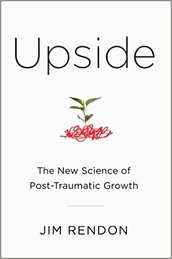
I came to Upside: The New Science of Post-Traumatic Growth by Jim Rendon as a woman who has endured PTSD caused by multiple sources: abuse, childbirth, health trauma, and if you believe in past lives, World War II. I have been able to achieve major healing with most of my wounds through alternative therapies; conventional therapy was only serving to retraumatize me. Yet as someone with a Ph.D., I have a great deal of respect for science and the advances it can help bring. Rendon's work questions why so many people who have endured traumas and PTSD are able to come to a place of positive growth through examining the influence of personal narratives, community support, honest communication, optimistic thinking, religion, creative outlets, physical exercise, fellow sufferers, and therapy. The studies and examples Rendon cites demonstrate that these factors can all contribute to a lifelong positive change.
Rendon’s work is firmly grounded in scientific studies which demonstrate how trauma can lead to growth. The book is well-researched, fluently integrated and easy to read. Rendon’s writing style makes academia accessible to the general public. Despite the heavy topic, I breezed through Upside much quicker than I read most nonfiction books. The stories Rendon relates about others who have suffered traumas are painful to read, but only one was horrifying to me because of the explicit violence it contains. (For those who are highly sensitive like me, I recommend skipping the details in the last chapter on Jake Harriman's trauma, an event that occurred in the war in Iraq.)
Rendon was drawn to the topic of post-traumatic growth because his father was a Holocaust survivor; he makes no indication of having endured major trauma in his own life either explicitly or implicitly. There were times where I felt his text would have benefited from an extra reading and feedback before publication by those who have lived through trauma themselves because Rendon’s perspective sometimes doesn’t quite grasp the full reality. However, for the most part, Rendon does an excellent job of vividly relating the pain and the growth that his subjects experienced. He also gives one of the best summaries I’ve read about how PTSD creates a hypersensitive response in individuals whose “fight or flight” response is perpetually in overdrive. The first few chapters of the book could be incredibly helpful to someone trying to understand their loved one’s new reactions to the world.
If one were to survey the trauma-inducing events that Rendon discusses in detail, one would conclude that trauma is caused by cancer, accidents, warfare, and natural disasters. I realize that Rendon had limited space in his book, but he chose to relate cancer patient after cancer patient’s experience. This is typical of our culture which actually creates additional trauma for those who aren’t enduring cancer: they are second class citizens in the world of medical trauma. This blog post discusses how Lyme patients like me are abandoned by friends and medical practitioners in their search for health while simultaneously being told, “At least it isn’t cancer.” By not addressing other illnesses beyond cancer and accidents, Rendon contributes to the cultural mythologies of what illnesses “should” look like.
My largest complaint about Upside is that it contains a blatant disregard for women’s traumas. It was not until chapter five that Rendon discussed a female case study; from there on, women were mentioned fairly regularly in the book. However, Rendon does not discuss a single case of rape, sexual harassment, or abuse in detail. These are major causes of trauma, but they are barely mentioned in passing and there are no specific examples of them in the text. Most frustrating to me was how Rendon described trauma from childbirth: “People can be traumatized from the happiest of situations: childbirth.” While on one level this is a true statement, on another level it shows a total lack of understanding for the epidemic proportioned reality of what most women still endure during childbirth in our nation. There are two primary times when no doesn’t mean no: when a woman is being raped or when she is in labor. Had Rendon taken the time to talk with women who have experienced what is known as “birth rape” in some circles or tbose who have lost their babies, he would not have made such a flippant comment about the joy of childbirth, and the trauma around childbirth would likely have merited more than a few brief paragraphs in this work.
I will definitely recommend Upside to many clients, primarily the family members and friends of those enduring traumas around war, cancer, or accidents. I will also recommend it to individuals who, as Rendon notes in the text, have already come to the recognition on their own that their traumas can serve for positive growth. The book would serve well in a college classroom of psychology, medical, nursing or social work students trying to begin to understand trauma. However, for those who are dealing with childbirth trauma, rape, or abuse, Upside is not necessarily the best place to find information about healing.
© 2015 Elizabeth Galen, Ph.D., Green Heart Guidance, LLC
 RSS Feed
RSS Feed